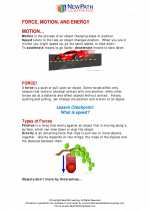Force, motion and energy -> velocity
Velocity
Velocity is a measure of the rate and direction of an object's motion. It is a vector quantity, meaning it has both magnitude (speed) and direction. The formula for calculating velocity is:
Velocity (v) = Displacement (Δx) / Time (Δt)
Where Δx is the change in position and Δt is the change in time. Velocity is typically measured in meters per second (m/s) or kilometers per hour (km/h).
Calculating Velocity
To calculate the velocity of an object, you need to know its displacement and the time it took for the displacement to occur. For example, if a car travels 100 meters in 20 seconds, the velocity can be calculated as:
Velocity = 100 m / 20 s = 5 m/s
Understanding Velocity
Velocity is different from speed, as it includes the direction of the motion. For example, a car traveling at 60 km/h due north has a different velocity than a car traveling at 60 km/h due south, even though they have the same speed. Velocity can be positive, negative, or zero, depending on the direction and nature of the motion.
Graphing Velocity
Velocity can be represented graphically on a distance-time graph or a displacement-time graph. On a distance-time graph, the velocity is the slope of the line, while on a displacement-time graph, it is the slope of the curve.
Study Guide for Velocity
- What is velocity and how is it different from speed?
- Explain the concept of velocity as a vector quantity.
- Describe how to calculate velocity using the velocity formula.
- Provide examples of positive, negative, and zero velocities in real-life scenarios.
- Discuss the graphical representation of velocity on distance-time and displacement-time graphs.
Understanding velocity is crucial in understanding the motion of objects and is a fundamental concept in physics and everyday life.
[Velocity] Related Worksheets and Study Guides:
.◂Science Worksheets and Study Guides Fourth Grade. Force, motion and energy

 Activity Lesson
Activity Lesson
 Worksheet/Answer key
Worksheet/Answer key
 Worksheet/Answer key
Worksheet/Answer key
 Worksheet/Answer key
Worksheet/Answer key
 Worksheet/Answer key
Worksheet/Answer key
 Vocabulary/Answer key
Vocabulary/Answer key
 Vocabulary/Answer key
Vocabulary/Answer key
 Vocabulary/Answer key
Vocabulary/Answer key
